阅读本文需要对ReactiveCocoa足够了解,也可以参阅图解ReactiveCocoa基本函数(http://www.jianshu.com/p/38d39923ee81)
Cocoa Touch Framework无疑是一个很好的框架,特别是对动画的支持,在我接触过的框架中可能是最好的(当然我接触的框架可能比较少),但是就UITableView来说确实存在很多吐槽点,从我个人理解的角度做些分析,尝试去解决这些吐槽点,并给到的解决方案。
UITableView枚举滥用
枚举从来都是为了可扩展而存在的,UITableView中对UITableViewStyle的使用堪称滥用,先看看这个枚举的定义,枚举项的命名不够直观,源码的注释也得不到有效信息,
typedef NS_ENUM(NSInteger, UITableViewStyle) {
UITableViewStylePlain, // regular table view
UITableViewStyleGrouped // preferences style table view
};
再看看如下文档的说明,基本明确了设计者的本意,UITableViewStyle想要区分的是页眉或页脚(section headers or footers)是否浮动,接下来做个剖析:
case plain
A plain table view. Any section headers or footers are displayed as inline separators and float when the table view is scrolled.
case grouped
A table view whose sections present distinct groups of rows. The section headers and footers do not float.
UITableView的初始化函数
- (instancetype)initWithFrame:(CGRect)frame style:(UITableViewStyle)style; // must specify style at creation. -initWithFrame: calls this with UITableViewStylePlain
-
UITableViewStyle作为初始化函数的参数的不合理性,大多数的UIView及其子类都是一样风格的初始化函数,到了UITableView这里就显得有点另类,设计者将 UITableViewStyle放到初始化函数中作为参数,无非就是不希望style在UITableView初始化之后被改变,可能原因是UITableView滑动的过程中style被改变了,不管之前是否存在浮动的页眉或页脚,改变之后对UI的呈现可能是比较突兀的,另外这种变更可能并没有实际意义;
-
UITableViewStyle的存在不合理,当一个枚举只存在两个选项时,很多时候会考虑使用BOOL来表示,可读性也不差,比如这里用isSectionGrouped,可能时不需要看注视或者文档就可以理解了;
-
UITableViewStylePlain的命名不合理,我们知道UITableView总是会分section,
-
Plain从其语义和StoryBoard默认值的显示可以联想UITableViewStylePlain可能是想表示只有一个section的情况,那么所谓的页眉或页脚是否浮动其实就没有太大意义,如果页眉或页脚不需要浮动其实就是一个Cell了,因为最终效果都是一样的,反过来假设需要多个section,但是页眉或页脚都不需要浮动,那么这些页眉或页脚其实用Cell来表示是不是更好呢!
综上得出结论:UITableViewStyle是不该用。
UITableViewCell枚举乱用
UITableViewCell存在好几个枚举的乱用,乱用表示不该用的时候用了。
UITableViewCellStyle的乱用
typedef NS_ENUM(NSInteger, UITableViewCellStyle) {
UITableViewCellStyleDefault, // Simple cell with text label and optional image view (behavior of UITableViewCell in iPhoneOS 2.x)
UITableViewCellStyleValue1, // Left aligned label on left and right aligned label on right with blue text (Used in Settings)
UITableViewCellStyleValue2, // Right aligned label on left with blue text and left aligned label on right (Used in Phone/Contacts)
UITableViewCellStyleSubtitle // Left aligned label on top and left aligned label on bottom with gray text (Used in iPod).
};
UITableViewCell的初始化方法中同样也带上了UITableViewCellStyle,先看代码
// Designated initializer. If the cell can be reused, you must pass in a reuse identifier. You should use the same reuse identifier for all cells of the same form.
- (instancetype)initWithStyle:(UITableViewCellStyle)style reuseIdentifier:(nullable NSString *)reuseIdentifier;
如果说UITableView设计者觉得就只存在两种style,那么UITableViewCell设计中加入UITableViewCellStyle就显得完全是乱用了。一样的道理,枚举从来就不是为了扩展而存在,UITableViewCell做为cell的基类,扩展是必须的,不可能所有的cell都长的跟UITableViewCellStyle中定义的几个枚举项所分类的完全一样,所以这个设计是有多恶心啊。
再看看UITableViewCellStyle的各个枚举项的命名,简直是残暴啊,UITableViewCellStyleValue1,UITableViewCellStyleValue2这些是什么鬼哦,再看看注释,分别说明Used in Settings和Used in Phone/Contacts,这就很明显了,这些实现完全就是系统组件用到了这样的实现,然后直接做为api开放出来的,并没有做很好的抽象,在初始化函数中加入UITableViewCellStyle,污染了初始化函数,限制了扩展,每每在写一个UITableViewCell的子类时,总是有一种莫名的哀伤,UITableViewCellStyle做为参数存在唯一的作用就是多写了点代码,然后没有任何意义。这些cell style所表示的cell完全应该通过子类化来实现的,所以UITableViewCellStyle的乱用是有点惨不忍睹的。
UITableViewCellSeparatorStyle的乱用
typedef NS_ENUM(NSInteger, UITableViewCellSeparatorStyle) {
UITableViewCellSeparatorStyleNone,
UITableViewCellSeparatorStyleSingleLine,
UITableViewCellSeparatorStyleSingleLineEtched // This separator style is only supported for grouped style table views currently
};
怎么说也不应该存在这样一个枚举,CellSeparatorStyle这里针对不同的UITableViewStyle而设计的,不管是何种style,应该只需要isShowCellSeparatorLine这样一个BOOL值表示是否需要显示边框,如果是UITableViewStyleGrouped这种style,可能需要额外的一个isCellSeparatorLineEtched,如果根据前面的假设,页眉或页脚都是默认浮动的话,这样设计是很合理的。
当一个枚举各项的命名过于诡异时,这个枚举的存在实际上是要好好考虑下的,所以UITableViewCellSeparatorStyle也是典型的乱用。
UITableViewCell对以下枚举的使用也是有待商榷的
typedef NS_ENUM(NSInteger, UITableViewCellSelectionStyle) {
UITableViewCellSelectionStyleNone,
UITableViewCellSelectionStyleBlue,
UITableViewCellSelectionStyleGray,
UITableViewCellSelectionStyleDefault NS_ENUM_AVAILABLE_IOS(7_0)
};
UITableViewCellSelectionStyle想表示cell选中的样式,这里大概是通过这种方式来提高几种默认值,因为CellSelectionStyle还是可以定制的,但是UITableViewCellSelectionStyleDefault放在最后UITableViewCellSelectionStyleNone放在最开始,到底谁是default哦;
typedef NS_ENUM(NSInteger, UITableViewCellFocusStyle) {
UITableViewCellFocusStyleDefault,
UITableViewCellFocusStyleCustom
} NS_ENUM_AVAILABLE_IOS(9_0);
UITableViewCellFocusStyle这个枚举的存在难道仅仅是为了无病呻吟吗?
UITableView委托乱用
UITableViewDelegate,UITableViewDataSource,包括刚引入的UITableViewDataSourcePrefetching,这几个delegate的设计好像是缺少了些设计,更像是为了解决问题而写代码,作为一个基础框架,实在是不可取的。
UITableViewDelegate设计之重
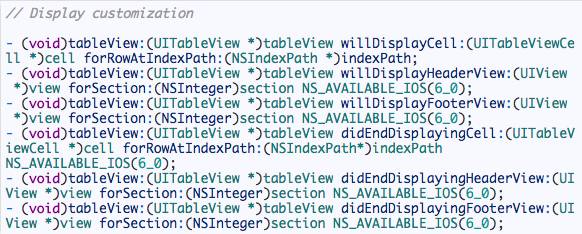
这几个委托函数,都是与Cell、页眉、页脚相关的,但是全都集中在UITableViewDelegate这个委托中,且命名都是类似,当一个protocol在定义时存在过多的@optional委托函数时,这个protocol的设计本身就是不合理的,应该拆分成更细的protocol,我们应该时在必要的时候选择相应的protocol,而不是实现存在的@optional委托函数,然后UITableViewDelegate这个protocol本身所有的委托函数都是@optional,这是真的不合理,如果是我们来设计Cell、页眉、页脚实际上都是应该UIView,且存在诸多共同点(参考UICollectionView的设计,Cell、页眉、页脚就存在一个共同的基类UICollectionReusableView),应该设计一个UIReusableView,(UICollectionReusableView也可以不需要了)其中存在如下方法,这些方法可以在子类中重写
- (void)willAppear;
- (void)didAppear;
- (void)willDisappear;
- (void)didDisappear
且应该设计一个UIReusableViewDelegate,其包括如下委托函数
- (void)willAppear:(UIReusableView*)reusableView;
- (void)didAppear:(UIReusableView*)reusableView;
- (void)willDisappear:(UIReusableView*)reusableView;
- (void)didDisappear:(UIReusableView*)reusableView;
UIReusableView存在UIReusableViewDelegate的一个delegate,前面所提到的那六个委托函数,实际上应该在Cell、页眉、页脚各自需要的时候实现UIReusableViewDelegate。
综上,UITableViewDelegate实际上是太重了。
UITableViewDelegate职责之乱
下面这些委托函数,实际上应该存在UITableViewDataSource中。页眉、页脚的数据源跟cell的数据源应该是平等的存在,不应该是说不常用了,我就放到UITableViewDelegate中,本来就应该放在UITableViewDataSource,不必须用的可以optional修饰下也还说得过去。
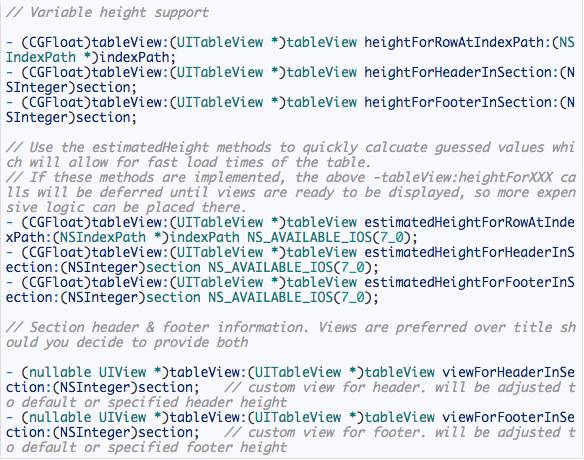
UITableViewDataSource设计之重
经过前面的梳理,那么UITableViewDataSource中应该包括以下这些函数

跟前面提到UITableViewDelegate设计之重一个道理,Cell、页眉、页脚的DataSource也是应该分开的,在需要的时候实现对应的DataSource,需要定义额外的一个枚举UIReusableViewType
typedef NS_ENUM(NSInteger, UIReusableViewType) {
UIReusableViewTypeNone,
UIReusableViewTypeHeader,
UIReusableViewTypeFooter
};
然后对页眉、页脚就有UIReusableViewDataSource,其中的委托函数如下:
- (nullable NSString *)reusableView:(UIReusableView*)reusableView reusableViewType:(UIReusableViewType)reusableViewType titleInSection:(NSInteger)section;
- (nullable UIView *)reusableView:(UIReusableView*)reusableViewreusableViewType:(UIReusableViewType)reusableViewType viewInSection:(NSInteger)section;
- (CGFloat)reusableView:(UIReusableView*)reusableView reusableViewType:(UIReusableViewType)reusableViewType estimatedHeightInSection:(NSInteger)section;
单独的针对cell,有UITableViewCellDataSource,其中的委托函数如下:
- (NSInteger)numberOfSections;
- (NSInteger)numberOfRowsInSection:(NSInteger)section;
- (UITableViewCell *)cellForRowAtIndexPath:(NSIndexPath *)indexPath;
- (CGFloat)heightForRowAtIndexPath:(NSIndexPath *)indexPath;
至于UITableViewDataSourcePrefetching就不应该出现,为了优化滚动帧率,拆东墙补西墙之举。从开发者的角度,最简单的做法就是把整个的数据源给到,剩下的就应该是UITableView自身去实现了,数据都有了,想要什么预加载都是框架自身的事情了,减少对开发者的依赖,更是减少api的耦合度,对外暴露的接口越多越不好。
改造之路在何方?
前面在吐槽的时候,每每会给出自认为更合理的设计,然而并没有什么卵用,既有代码是无法修改的,那改造之路又在何方呢?不能改变既有代码,那么只能是将这么东西尽可能的封装起来,Objective-C语言还提供了一个蛮有意思的编译期常量NS_UNAVAILABLE,可以在编译期禁用父类的方法,算是不完美中的完全吧,我们可以禁用掉一些不合理的类成员,来达到一个比较好的封装效果。
UITableView枚举滥用的解决
UITableView可以禁用被枚举污染的初始化函数,重写默认的initWithFrame初始化函数并默认设style为UITableViewStyleGrouped,参考类 LPDTableView暂时并没有重写初始化函数,目前认为无伤大雅。
UITableViewCell枚举乱用的解决
UITableViewCell无法禁用被枚举污染的初始化函数,因为重用时会调用到,参考类 LPDTableViewCell,选择无视UITableViewCellStyle,并将已存在的几种cellStyle都扩展成对应的子类,LPDTableViewDefaultCell,LPDTableViewValue1Cell,LPDTableViewValue2Cell,LPDTableViewSubtitleCell命名还是保留一致,毕竟大家都已经习惯了这种丑。
UITableView委托乱用的解决
既然无法改造既有的UITableView,可以从另外一个侧面来解决。
UITableView如何数据驱动
引入MVVM的思想,为UITableView添加对应的ViewModel,有了ViewModel,则可以引入数据驱动的方式,当我们需要为Cell、页眉、页脚提供DataSource时,只需要调用LPDTableViewModelProtocl中的方法就好了,接口的粒度已经比较细了,但可能不是最合理的组合,相关的函数都在下面:
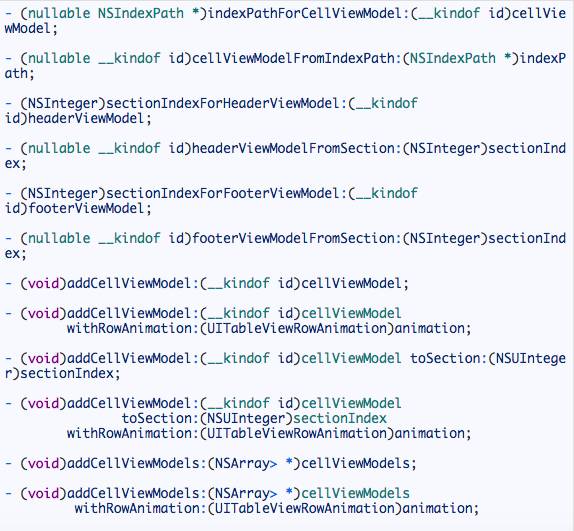
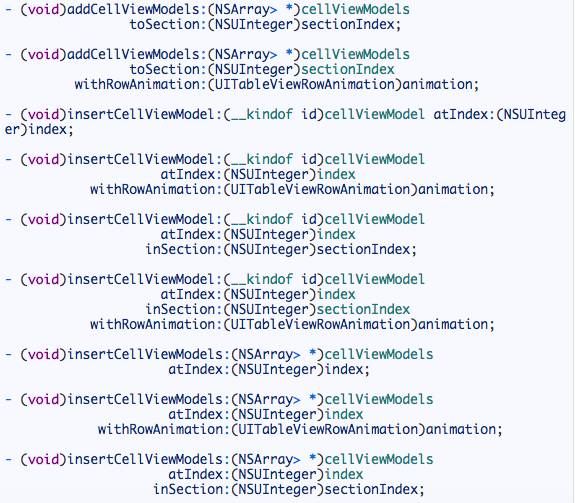
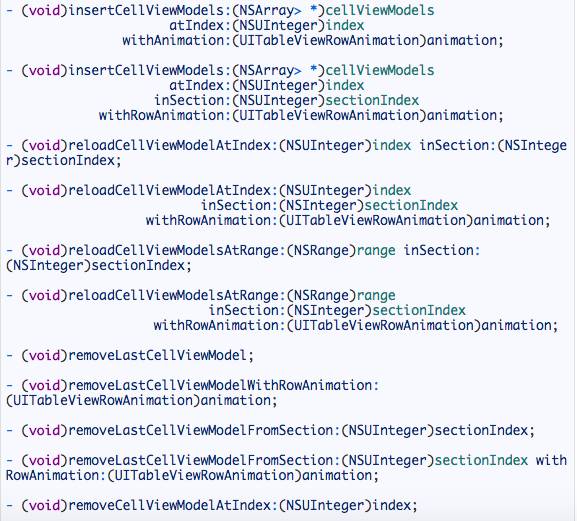
UITableView委托转RACSignal
引入ReactiveCocoa中的RACSignal,将UITableViewDelegate中的委函数都转成信号,当我们需要实现某一个委托函数,只需要订阅对应的RACSignal即可,不订阅没有任何副作用。

Cell、页眉、页脚也存在相应的ViewModel
Cell、页眉、页脚跟其ViewModel之间需要遵守约定好的命名规则,如此会自动匹配。另外Cell、页眉、页脚默认都是重用的,同一类型reuseIdentifier一样,重用相关的函数就都在 LPDTableViewFactory。这个类中了当我们关心DataSource或者Delegate时,我们只需要跟对应的ViewModel交互即可,将Cell、页眉、页脚解耦合。
LPDTableSectionViewModelProtocol
这个protocol的实现类LPDTableSectionViewModel,只是在ViewModel层抽象出来,这样才好完善ViewModel层的实现,并不存在对应的SectionView。
关于height
cell,header,footer的viewmodel中都有对应的height字段,需要根据viewmodel的model字段在bindingTo:viewModel函数中设置height值,可以针对model做height的缓存。
改造之后的例子
加载tableview的数据
-(void)reloadTable {
if (self.datas && self.datas.count > 0) {
NSMutableArray *cellViewModels = [NSMutableArray array];
for (LPDPostModel *model in self.datas) {
LPDTablePostCellViewModel *cellViewModel = [[LPDTablePostCellViewModel alloc]initWithViewModel:self.tableViewModel];
cellViewModel.model = model;
[cellViewModels addObject:cellViewModel];
}
[self.tableViewModel replaceSectionWithCellViewModels:cellViewModels withRowAnimation:UITableViewRowAnimationTop];
}else{
[self.tableViewModel removeAllSections];
}
}
添加一个cell
LPDPostModel *model = [[LPDPostModel alloc]init];
model.userId = 111111;
model.identifier = 1003131;
model.title = @"First Chapter";
model.body = @"GitBook allows you to organize your book into chapters, each chapter is stored in a separate file like this one.";
LPDTablePostCellViewModel *cellViewModel = [[LPDTablePostCellViewModel alloc]initWithViewModel:self.tableViewModel];
cellViewModel.model = model;
[self.tableViewModel insertCellViewModel:cellViewModel atIndex:0withRowAnimation:UITableViewRowAnimationLeft];
批量添加cell

删除一个cell
[self.tableViewModel removeCellViewModelAtIndex:0 withRowAnimation:UITableViewRowAnimationRight];
Cell的didSelectRowAtIndexPathSignal
[[[self.waybillsTableViewModel.didSelectRowAtIndexPathSignal deliverOnMainThread]
takeUntil:[self rac_willDeallocSignal]] subscribeNext:^(RACTuple *tuple) {
@strongify(self);
__kindof id cellViewModel = tuple.second;
LPDWaybillModel *waybillModel = cellViewModel.model;
if (waybillModel.cancelCode == 0) {
LPDWaybillDetailViewModel *detailViewModel = [[LPDWaybillDetailViewModel alloc] init];
detailViewModel.waybillId = waybillModel.waybillId;
[self.navigation pushViewModel:detailViewModel animated:YES];
}
}];
具体请下载lpd-tableview-kit(https://github.com/LPD-iOS/lpd-tableview-kit),看看其中的demo。